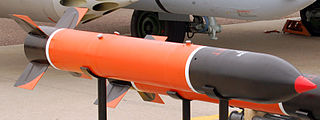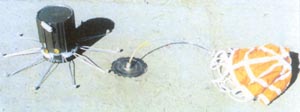
The S-24 is a rocket weapon designed and used by the Soviet Air Force. It remains in use by the Russian Aerospace Forces and the Indian Air Force. The name is based on the diameter of the rocket, 24 cm (9.4 in).

The VS-2.2, VS-3.6 and SH-55 are Italian circular plastic cased anti-tank blast mines that use the VS-N series fuze. They have very few metal components and are resistant to overpressure and shock. The VS-2.2 and VS-3.6 can also be deployed from helicopters. It was produced by Valsella Meccanotecnica and Singapore, but production has ceased. The VS-2.2 and VS-3.6 are essentially the same, the VS-3.6 being slightly larger, the SH-55 is larger still and has a more rounded appearance. A smaller mine, the VS-1.6 also uses the same fuze.
The Panzer-Stabmine 43 was a German anti-tank mine, together with the Hohl-Sprung mine 4672 it was the first mine to combine a shaped charge warhead with a tilt-rod fuze. The mine was developed during the Second World War. The mine consisted of a wine glass shaped metal main body mounted on a wooden post, with a tilt rod holding arm projecting to one side. It used a 125 mm diameter warhead with 1.6 kg of explosive, and a combination pressure/tilt fuze.
The M21 is a circular United States anti-tank landmine that uses a Misznay Schardin effect warhead. The mine uses an M607 pressure fuse, which can be adapted as a tilt rod fuze. The mine is triggered either by pressure, or by the tilt rod being forced beyond 20 degrees from the vertical by a force of more than 1.7 kg, either of these actions results in pressure being transferred via a bearing cap to a Belleville spring, which inverts, driving the firing pin into the M46 detonator. The M46 charge first ignites a black powder charge, which blows off the mine's cover, and clears any earth or debris that may have been on top of the mine. A fraction of a second later the main warhead detonates, driving and compressing a steel plate upwards, with enough force to penetrate 76 mm of armour at a distance of 530 mm. Approximately 200,000 M21 mines were produced in the U.S. and a licensed copies, the K441 and K442, were produced in South Korea.

The TMA-3 is a circular Yugoslavian minimum metal anti-tank blast mine. It is very similar in appearance to the TMA-4. The mine consists of a cast circular block of explosive cased in resin reinforced fabric. The top of the mine has three fuze wells which each take a UTMA-3 fuze, and a fourth secondary fuze well is provided in the base of the mine to fit an anti-handling device. The fuze wells may also accept a number of other fuzes, including the UPROM-1, and other fuzes, potentially allowing tripwire activation. The small pressure plate area of the UTMA-3 fuzes gives the mine good resistance to minefield clearance techniques which used blast overpressure techniques i.e. explosive charges.
The FMK-1 is a small circular Argentina anti-personnel blast mine which, when fitted with a stiffened pressure plate, is also used as the fuze for the FMK-3 and FMK-5 anti-tank mines. The mine has a circular plastic body, with a number of small ribs running vertically around the outside of the mine, with the circular detonator and striker protruding on each side. The pressure plate has a distinctive six pointed star shape ribbing for stiffness. The bottom of the mine has small base plug inside which a small stud is installed. The stud increases the activation pressure of the mine. A metal detector disc can be added to the bottom of the mine, but it is not often used. It is actually in service with the Argentine Army.
The PT Mi-U is a circular Czech anti-tank mine with a Misznay Schardin effect warhead. It can be used with a conventional pressure fuze or a tilt rod fuze.
The VS-SATM1 is an Italian scatterable anti-tank landmine that was produced by Valsella Meccanotecnica SpA. The mine can be scattered by a GRILLO-128 man-portable single-tube launcher system or a VS-MDH helicopter based system. The mine has six pop-out fins which slow its descent and improve the dispersion characteristics.
The 4AHM-100, AHM-200, AHM-200-1, AHM-200-2, PMN-150, and PMN-250 are Bulgarian directional fragmentation mines that can be used with proximity fuzes to function as anti-helicopter mines.
The ATM 2000 and ATM 2000E are Austrian plastic cased anti-vehicle mines using Misznay Schardin effect warhead. The mine uses an electronic microprocessor controlled fuze with magnetic, seismic and pressure sensors allowing it to discriminate between targets. The mine can be laid by hand or by a mechanical mine laying system, and arms ten minutes after being laid. The mine is fitted with an anti-handling device, and can be command detonated.
The VS-HCT series of mines are Italian plastic cased anti-tank mines that use Misznay Schardin effect warheads and have a dual seismic and magnetic fuze. The mines are no longer produced and differ in size and shape.

The M2 is a United States bounding anti-personnel mine used during World War II. A number of variants of the mine were produced and although the mine is no longer in US service, it can be found in Cyprus, Iran, Iraq, Korea, Laos, Oman, Rwanda, Tunisia and the Western Sahara. Copies of the mine were produced by Belgium, Pakistan (P7), Portugal (M/966) and Taiwan.

The HPD-1, HPD-2 and HPD-3 are a series of French electrically fuzed anti-tank landmines that use Misznay Schardin effect warheads. The entire series of mines conform to the United States MIL-STD-331.
The VAR/40, VAR/100 and VAR/100/SP are Italian anti-personnel blast landmines produced by the Tecnovar italiana S.p.A. company.

The MN-111 is a Polish air-dropped anti-tank landmine. The mine is designed for use on soft ground. The mine is cylindrical with six spring-loaded fins attached to one end of the mine, with the cylinder drawn to a point at the opposite end which is topped with a small wind vane. The mine is stored with the fins wrapped round the outside of the mine. Once the mine is dropped from the aircraft the fins spring outward, acting as a drag parachute, slowing the rate of descent to a peak speed of about 60 meters per second. As the mine drops the wind vane spins, generating the power used to arm the mine.

The MN-121 is a Polish scatterable anti-tank mine, externally similar to the German AT-2 mine. The mine is cylindrical with ten wire legs which fold outward to keep the mine upright. The mine uses a magnetic influence fuze, which triggers the mine when a vehicle passes over it. The mine also has an anti-handling device which triggers the mine if it is moved. The mine's warhead is a shaped charge design containing approximately 700 grams of RDX. The manufacturer claims that it is capable of penetrating 60 millimeters of armour at an offset of half a meter.
The MSM MK2 is a Finnish belly attack anti-tank mine. The mine has a circular ribbed plastic case that is tapered towards the bottom. It uses an electronic fuze with a combination magnetic and seismic fuze; it also has an anti-handling device. The mine is armed by inserting an arming pin, which completes an electronic circuit. The mine indicates that it is armed by lighting a small LED light which switches off after 10 minutes. When a vehicle approaches, vibrations travelling through the ground trigger the seismic sensor, which activates the magnetic sensor. When a vehicle passes over the mine, the warhead is triggered. First a clearing charge fire, removing up to 100 millimeters of earth from the top of the mine, then a copper-lined Misznay Schardin effect warhead is triggered. This projects a slug of copper at high velocity into the bottom of the target.
The TM-72 is a Soviet cylindrical metal-cased anti-tank mine. It is normally used with the MVN-72 or MVN-80 magnetic influence fuzes, which give it a full width attack capability. It uses a 2.5 kg shaped charge warhead capable of penetrating approximately 100 millimeters of armor at a standoff distance of between 0.25 and 0.5 meters. It is compatible with the fuzes used with the TM-62 series of mines.
The T-93 is an Egyptian scatterable anti-tank mine similar in appearance to the German AT-2 scatterable mine. It can be dispensed from launchers deployed on the ground or mounted on vehicles which can hold as many as 600 mines. The mine is cylindrical with twelve spring-loaded legs folded up against the sides of its body during storage. After the mine is dispensed and strikes the ground, the legs spring open, pointing the mine upright.
In military munitions, a fuze is the part of the device that initiates function. In some applications, such as torpedoes, a fuze may be identified by function as the exploder. The relative complexity of even the earliest fuze designs can be seen in cutaway diagrams.







